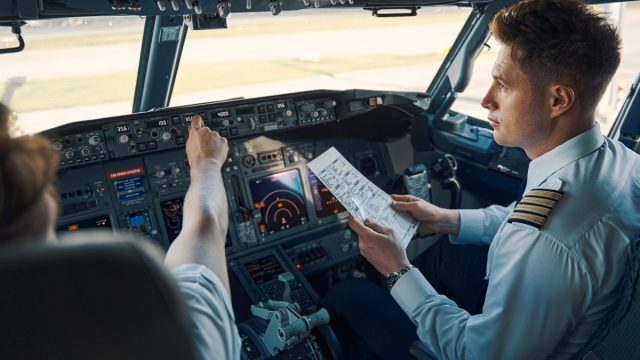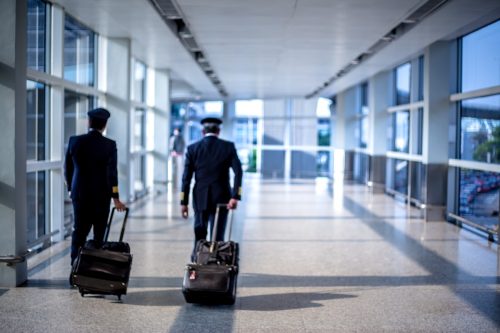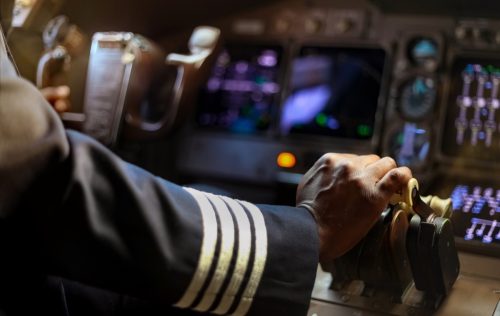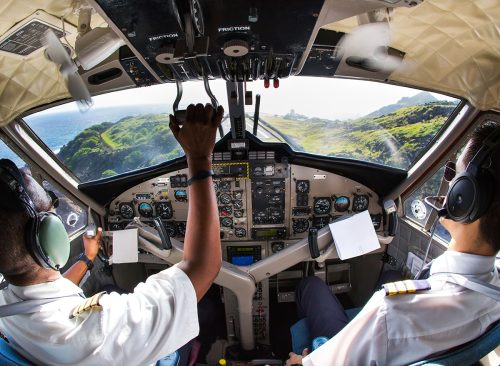Pilots Warn of "Growing Danger" on Flights Amid Staffing Shortages
Some are calling for a rule change to combat the recent increase in near-miss incidents.

Back in January, a close call between a Delta Air Lines plane and an American Airlines flight almost resulted in a runway collision at JFK International Airport in New York City. Then, just last month, a similar incident happened at Boston Logan International Airport with a Spirit aircraft and another American Airlines flight. These near-miss events not only surely caused panic for passengers aboard those planes but have also concerned other travelers who don't want to find themselves in a similar—or worse—situation. And the worry may not be misplaced, as pilots themselves are also speaking out about near-collisions amid crew staffing shortages. Read on to discover why pilots are warning of "growing danger" on flights and how one organization wants to combat it.
RELATED: JetBlue Is Cutting Flights to 6 Major Cities, Starting Oct. 28.
Near-miss incidents have been increasing in frequency.

On Aug. 21, The New York Times released a new investigative report about near-miss incidents at airports. According to the newspaper's analysis of internal Federal Aviation Administration (FAA) records, close calls involving commercial airlines have been happening multiples times a week on average this year. There isn't a single major airline that hasn't been involved in one in 2023.
FAA spokesman Matthew Lehner told The New York Times that the rate of runway incursions (when planes get too close to each other at airports) is nearly 25 percent higher now than it was a decade ago. In addition to the FAA data, the newspaper's reporters also analyzed a database maintained by NASA that contains confidential safety reports filed by pilots, air traffic controllers and others in aviation and found that it indicates a similar concern: There were approximately 300 accounts of near collisions involving commercial airlines in the most recent 12-month period of data available—which means they have more than doubled over the past decade.
RELATED: Travelers Are Boycotting Southwest Over New Boarding Change.
This is happening amid staffing shortages.

The increase of near-miss incidents is occurring while the airline industry has been working to address staffing issues. Consulting firm Oliver Wyman recently released a report indicating that there is a shortfall of around 17,000 pilots in North America—which is expected to increase to 24,000 by 2026, CNN reported.
But there has been a significant push to hire more crew members for flights in the past few months—particularly when it comes to pilots, Henry Harteveldt, an aviation analyst at Atmosphere Research, told the news outlet. "The most critical group are the pilots, because there was a severe shortage last year," Harteveldt explained. "Airlines in the US have hired more than 10,000 pilots collectively."
RELATED: American Is Cutting Flights to 5 Major Cities, Starting Oct. 29.
Some pilots believe the required retirement age should be changed.

There is also a discussion happening regarding whether the retirement age for pilots should be raised, according to Harteveldt. Under current FAA guidelines, commercial airline pilots are required to retire once they reach the age of 65. Many pilots say this cap is compromising travel safety—and adding to the increase in near-miss incidents—as more and more experienced airline captains are being forced to leave their jobs, and their positions are being filled by pilots who have been working for a relatively short amount of time.
In a new interview with Simple Flying, members of the Let Experienced Pilots Fly organization said that "the situation is untenable" when "factoring in the loss of on-the-job training by more experienced pilots who mentor the less experienced pilots." According to the organization, there has been a rapid growth of younger pilots moving into positions with greater responsibilities or tasks than their training and experience would have traditionally allowed before the staffing shortage.
"We risk seeing an end to the historic, long-running safety record in aviation of no fatalities as a result of an aircraft incident. This is due to the (cumulative) growing danger of these circumstances and their impact on the system," Let Experienced Pilots Fly said. "When pilots are forced to retire at the top of their professional competency their skills, knowledge, experience, and leadership leaves with them."
A bill about the pilot retirement age could be passed soon.

As a result, many are pushing to extend the retirement age for pilots to 67. Back in July, the House of Representatives passed a bill called the Let Experienced Pilots Fly Act that would do just that—but the outcome of this legislation will depend on what members of the Senate decide, according to Simply Flying. The Let Experienced Pilots Fly organization told the news outlet that it believes raising the retirement age by two years would help address the "growing danger" in air travel, as it would ideally allow thousands of qualified pilots to continue flying and help train the next generation of captains.
Senator Mark Kelly, who has flown four Space Shuttle missions, also agreed that the act would be beneficial for travelers, Simply Flying reported. "The national shortage of pilots has caused too many delays and disruptions for travelers across the country," Kelly said in a statement, per Smith Anglin. "Our bipartisan legislation would allow experienced and highly skilled pilots to continue their careers past age 65, if they choose, which would help address staffing and travel challenges as we continue to strengthen the pilot pipeline."
For more travel news sent right to your inbox, sign up for our daily newsletter.





















